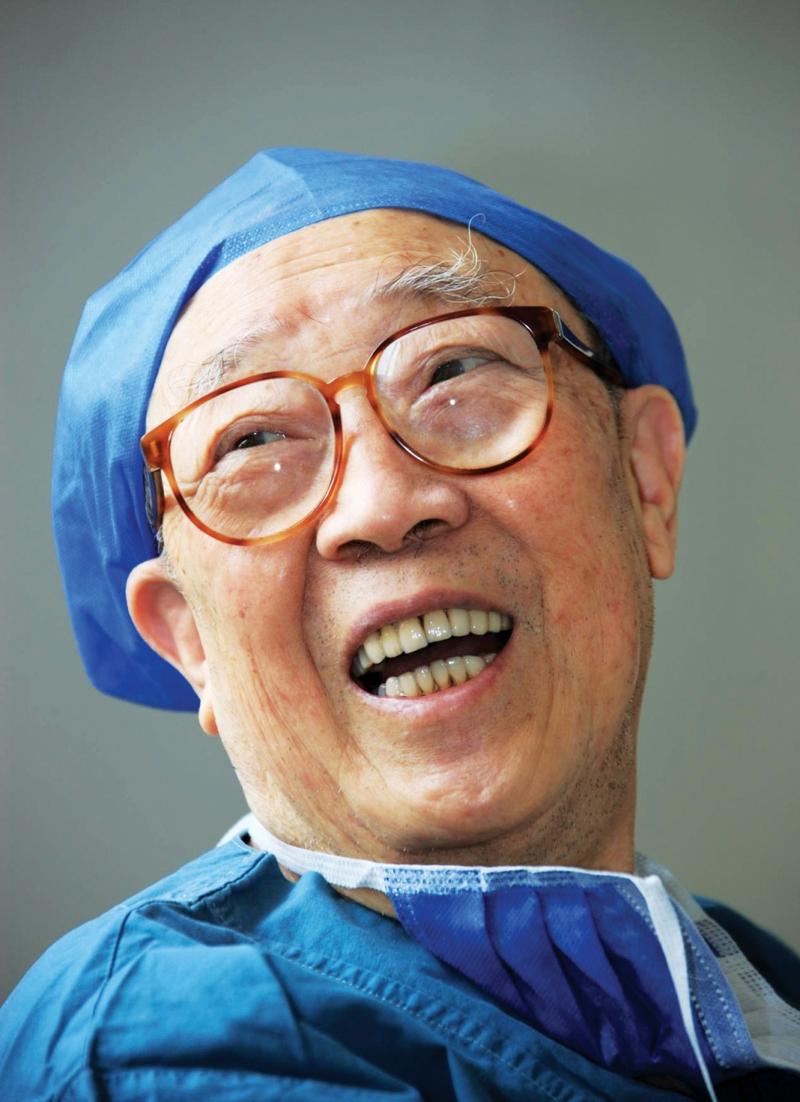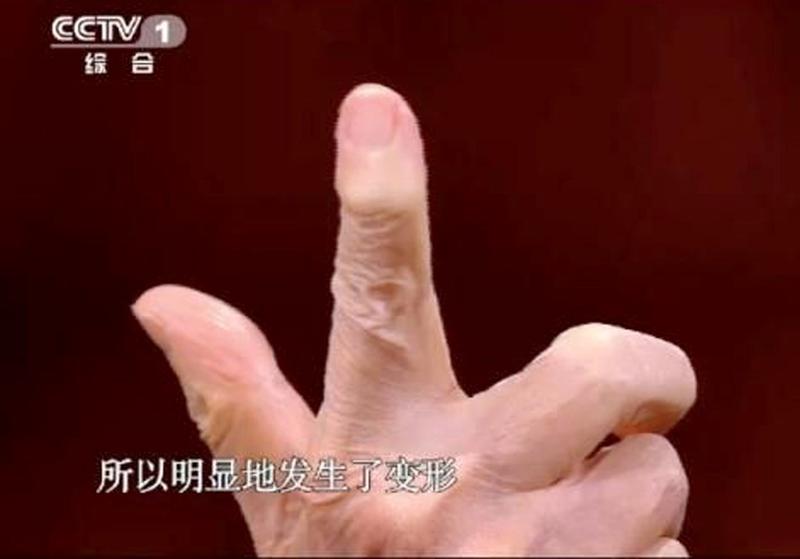 Wu Mengchao, China’s “Father of liver and gallbladder surgeries”. (WANG JIANMIN / XINHUA)
Wu Mengchao, China’s “Father of liver and gallbladder surgeries”. (WANG JIANMIN / XINHUA)
At an international conference in San Francisco in 1979, two proud foreign professionals announced they had, between them, performed 18 liver cancer operations. The audience looked at them with admiration.
When another speaker, Wu Mengchao, from China, took the stage, he took the participants by surprise by summing up his experience with as many as 181 liver cancer surgeries.
From his first successful liver surgery in 1960 to his retirement in 2019, Wu conducted more than 16,000 operations, including liver surgeries, and saved nearly 20,000 lives.
“Serving the patients is my mission in life,” Wu once told the media.
Wu, notwithstanding his diminutive physical frame — he stood just 1.62 meters tall — was a towering figure in China’s medical community and called “father of liver and gallbladder surgeries in China” thanks to his pioneering spirit, bold ingenuity, training of talents and lifelong devotion.
Wu’s life is interspersed with world records: completing the world’s first middle hepatic lobectomy in 1963; removing a liver tumor 68 centimeters in diameter and weighing 18 kilograms from a man in 1975; operating on a 4-month-old baby in 1984; and conducting the world’s first laparoscopic resection of liver tumors in the 1990s.
In fact, Wu developed liver surgery in China from scratch, even though he had not planned on being a surgeon when he was young.
Wu’s family moved to Malaysia in 1927 from Minqing county, in East China’s Fujian province, when he was five, to take up jobs as migrant workers in the rubber industry. By 1940, Wu left Malaysia and returned to China, hoping to join the army of the war-torn fatherland and fight the Japanese intruders.
During his transit in Ho Chi Minh City in Vietnam, a French customs officer asked Wu to press his fingerprints despite the fact he was literate and could sign his name like European travelers. After Wu insisted on signing, the officer scolded him, saying: “You’re the yellow race, the sick man of Asia, you cannot sign!”
“That moment of humiliation was branded into my heart and soul,” Wu said in a public lecture in 2012. “It was that moment I become determined to help my country grow stronger, so we won’t be bullied and discriminated against by foreigners.”
But the path to the communist army’s headquarters in Yan’an, Northwest China’s Shaanxi province, proved too perilous to travel, so Wu managed to get enrolled in a Shanghai school instead. After he graduated from Tongji University’s School of Medicine, he was assigned to a pediatric division, but he decided to quit that assignment to take up work in a surgery department in another hospital in Shanghai.
 Wu after a surgery in Shanghai Dongfang Liver and Gallbladder Hospital in 2011. (WANG JIANMIN / XINHUA)
Wu after a surgery in Shanghai Dongfang Liver and Gallbladder Hospital in 2011. (WANG JIANMIN / XINHUA)
In 1954, “Father of Chinese Surgery” Qiu Fazu came to the hospital as a part-time professor. Wu worked diligently with the renowned surgeon.
“Liver surgery is still weak in the world today, and China has been a region with a high incidence of liver diseases”, Qiu told him. It was then that Wu firmed up his goal and launched an effort in the field of hepatobiliary surgery.
In 1956 Wu’s colleagues told him of remarks from a visiting foreign surgeon that it would take at least 30 years for China to catch up with the rest of the world in liver operations.
“I wasn’t pleased hearing this comment, so I made it my mission to propel China’s liver and gallbladder surgery into the front-runners of the world,” Wu recalled.
At that time, domestic surgery expertise was far behind the international level, and a hepatobiliary surgery was highly risky. Due to the dense blood vessels in the liver, hemorrhage is likely to occur. To solve the difficult problem, it is necessary to use an anatomical model to figure out the complicated vessels.
Wu dug into information about the liver. In 1958 he published the country’s first basic textbook on liver surgery. Then, a research team of three headed by Wu stayed in a shabby laboratory every day, with only a table and a few stools. After more than four months of research, they finally created China’s first anatomical models for studying liver arteries.
Later they made hundreds of models to help them thoroughly understand the structure of the liver. These first models are still kept in the exhibition room at the Third Affiliated Hospital of the Naval Medical University in Shanghai, a medical facility that Wu helped found and where he worked for many decades.
Gaining knowledge and understanding, Wu came up with a revolutionary approach that divided a liver’s anatomy into “five lobes and four segments”, a significant improvement from the dual lobes model used by Chinese physicians in the past.
After studying the “enemy” thoroughly, Wu successfully performed the first liver surgery in China by 1960.
As the first Chinese doctor to establish a theoretical basis for liver surgery, Wu was responsible for more than 30 major medical achievements through independent innovation.
In the 1980s, he perfected a new technique of vascular inflow occlusion that can be performed at room temperature, instead of in controlled conditions. It is still used by surgeons around the globe today.
Moreover, he has taught roughly 80 percent of the current crop of experts and doctors that are specializing in liver surgeries in the country.
 A TV grab shows Wu’s fingers after decades of holding scalpels. (PHOTO PROVIDED TO CHINA DAILY)
A TV grab shows Wu’s fingers after decades of holding scalpels. (PHOTO PROVIDED TO CHINA DAILY)
Wu and his students also raised the completion rate of successful hepatic surgery for liver cancer patients in China from 16 percent to over 98 percent.
In 2004, a young woman patient named Wang Tiantian had a tumor larger than the size of a basketball. Many opposed the then 82-year-old Wu doing an operation on her as it could affect his reputation in the industry if the surgery failed. But he said it was his duty to save lives. Through a 10-hour-long operation, he removed the tumor, giving Wang a new life.
In 2013, a 90-year-old woman surnamed Chen was diagnosed with a large liver tumor, which was deemed inoperable by numerous hospitals due to her age and underlying health conditions.
Wu removed the 13-cm tumor in nine minutes and the patient lost less than 150 milligrams of blood.
The country rewarded the surgeon with many honors. Wu became the first physician to receive the State Preeminent Science and Technology Award, China’s highest academic accolade, in 2005.
The day he received the award, Wu walked into an operating room to perform a surgery as scheduled.
The Chinese hepatic surgeon spent so many hours standing and working in operation rooms that some of his fingers and toes became permanently deformed.
But this did not deter him from carrying out two to three surgeries per week, even in his 90s, for he knew he was many patients’ last hope for recovery. “I feel empty if not doing surgeries,” Wu said.
Fang Honghui, the author of Wu’s biography, called the physician’s disfigured hands, “the hands of god” capable of granting new life to the sick and helpless.
Wu said that his tutor, Qiu, often stressed that a doctor needs to have the moral standards of Buddha, and skills as deft as a heavenly deity.
Cheng Yue’e, a nurse who worked with Wu for over 30 years, recalled that in 2018 a particularly difficult surgery left Wu soaking in sweat.
“I am 96 years old, I can’t work as long as you youngsters, so I’ve got to make best use of every second I have,” Wu said. “So long as I live a day in this world, I will fight liver cancer for a day.”
After seven decades in medicine, Wu retired in 2019 at the age of 97, gaining fame as the world’s longest active liver surgeon.
On May 22, the nation’s top hepatobiliary surgeon who was also an academician with the Chinese Academy of Sciences, died at age 99 in Shanghai.
The death of Wu triggered an outpouring of grief as well as fond recollections of his achievements. Flowers were delivered from outside Shanghai via express delivery; and people paying tribute to him heard his favorite song “The Internationale” playing in the mourning hall.
Many of Wu’s students and colleagues went to the mourning hall on May 23 to pay their respects. Among them was Yang Tian, 40, who said Wu’s three teachings of being a good surgeon, communicator and writer were a major influence on his career.
Yao Xiaoping, 86, one of Wu’s first students and later a colleague, said the surgeon deserved the title of the “father of liver and gallbladder surgeries in China” as he not only tackled many challenges in the field, but also trained the majority of the country’s hepatic surgeons.
On May 26, people bid farewell to the revered surgeon at the Longhua funeral parlor in Shanghai. Many of them, remembering him as one of the country’s most inspiring luminaries, perhaps looked up at the sky later. There, asteroid 17606 carries Wu’s name, an honor bestowed in 2011 as a tribute to his contribution in the field of hepatic surgery.
He Qi contributed to this story.


